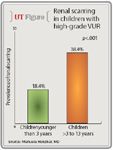Article
Vesicoureteral reflux in young patients: Early detection, treatment key
Results of a retrospective study investigating risk factors for the development of renal parenchymal damage in young children with primary high-grade vesicoureteral reflux (VUR) underscore the importance of early detection and treatment to prevent renal damage or its progression from ongoing VUR.

The study, which included data from 1,013 children diagnosed with grade III, IV, or V VUR prior to age 3 years and who had undergone dimercaptosuccinic acid (DMSA) scanning, identified only grade IV/V VUR and not being screened for sibling VUR as independent predictors of renal scarring for this age group. Compared with a cohort of 516 children diagnosed with grade III, IV, or V VUR at age >3 to 13 years, the prevalence of renal scarring in children diagnosed with VUR at a younger age was 50% lower: 18.4% versus 38.4%, respectively (p<.001).
"Reflux is recognized as the most common urological anomaly associated with urinary tract infections in children. It is also well known that renal parenchymal damage associated with VUR is a major cause of chronic renal failure and that the VUR-related damage occurs early, usually in children younger than age 3. We were interested in identifying risk factors that are associated with the development of renal scarring in these young children," said first author Manuela Hunziker, MD, of National Children's Research Center, Dublin, Ireland.
More scarring seen in older children
Of the 1,765 children, 1,529 had undergone DMSA scanning, and 384 (25.1%) of those children were found to have renal scarring. The prevalence of scarring was twice as high in the children diagnosed with VUR at an older age compared with those diagnosed at age <3 years, and the severity of renal scarring was also significantly higher in children diagnosed at >3 years of age compared to those diagnosed at <3 years of age.
In univariate analysis to identify risk factors associated with renal damage in the cohort of children diagnosed at less than 3 years of age, statistically significant associations were found for grade IV/V VUR, male gender, history of urinary tract infection, and not being screened for sibling VUR. However, on multivariate analysis, only grade IV/V VUR and not being screened for sibling VUR remained statistically significant predictors of renal scarring.
"Early detection and treatment of VUR may prevent renal damage due to ongoing VUR," Dr. Hunziker said.
Newsletter
Stay current with the latest urology news and practice-changing insights — sign up now for the essential updates every urologist needs.














